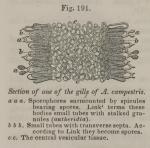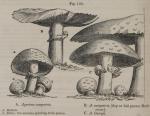 Agaricus edulis, Roques.—Fries [Systema Mycologicum, vol. i. p. 281, 1821.] considers this species to be the μύκης εδωδιμος of Dioscorides (lib. i. cap. 109); the Fungi qui rubent callo of Pliny (Hist. nat. lib. xxii. cap. 47). Μανιτάρι hodié Gr. Sibth.
Agaricus edulis, Roques.—Fries [Systema Mycologicum, vol. i. p. 281, 1821.] considers this species to be the μύκης εδωδιμος of Dioscorides (lib. i. cap. 109); the Fungi qui rubent callo of Pliny (Hist. nat. lib. xxii. cap. 47). Μανιτάρι hodié Gr. Sibth.
Agaricus, Linn. Hymenium consisting of plates radiating from a common centre, with shorter cones in the interstices, composed of a double closely connected membrane, more or less distinct from the pileus. Veil various or absent.—Named from Agaria, a region of Sarmatia (Berkeley).
A. campestris, Linn; pileus fleshy, dry, subsqnamose or silky, gills pink free ventricose, at length brown, stem stuffed, furnished with a ring white (Berkeley).
 Pileus or caps 2-5 inches broad, at first convex, then plano-convex, white or light brown, silky or clothed with reddish brown adpressed fibrillae collected into little fascicles; epidermis easily peeled off, projecting beyond the gills, and often curled back fleshy; flesh firm, thick, white, more or less stained with reddish brown, especially when bruised. Gills very unequal, at first of a beautiful pink, free, obtuse, and sometimes forked behind, broad in the middle; at length dark, mottled with brownish purple; the edge white, and minutely denticulate. Spores minute, elliptical, purplish brown immediately supported on spicules (sterigmata) which surmount the sporophores (basidia). Root consisting of branched fibres (mycelia). When quite young, there is a fine silky universal veil (Berkeley, with additions).
Pileus or caps 2-5 inches broad, at first convex, then plano-convex, white or light brown, silky or clothed with reddish brown adpressed fibrillae collected into little fascicles; epidermis easily peeled off, projecting beyond the gills, and often curled back fleshy; flesh firm, thick, white, more or less stained with reddish brown, especially when bruised. Gills very unequal, at first of a beautiful pink, free, obtuse, and sometimes forked behind, broad in the middle; at length dark, mottled with brownish purple; the edge white, and minutely denticulate. Spores minute, elliptical, purplish brown immediately supported on spicules (sterigmata) which surmount the sporophores (basidia). Root consisting of branched fibres (mycelia). When quite young, there is a fine silky universal veil (Berkeley, with additions).
If the pileus be cut through, the fleshy part soon turns pink, and drops of pink juice may be squeezed out of it if young; but if old, the cut part, as well as the juice, is rather inclining to brown, but the Agaricus Georgii turns yellow. The whole plant is rather brittle, and has a fine scent peculiar to itself (J. Sowerby, Jun.).
The mushroom is artificially produced either with or without spawn. Mushroom spawn is the name given by gardeners to the white, branching, cottony fibres (mycelia), which form the so-called root of the mushroom, and upon which, at short intervals, are many very small round buds (the infant state of the plant). This spawn is collected and saved by gardeners, and at the commencement of autumn is planted on beds of dung, and covered with straw: in about two months the mushrooms come up, and rapidly increase. Mixed with dung, and made up into rectangular cakes, it forms what are called spawn cakes or spawn-bricks. These are sold at Covent Garden Market, and are planted in beds.
Mushrooms are also propagated without spawn. The principal ingredient employed in preparing the compost used for this purpose is horse-droppings. [See Loudon's Encyclopaedia of Gardening.] "The artificial production of this species without the aid of spawn," says the Rev. M. J. Berkeley [English Flora, vol. v. part ii. p. 107.], "has been frequently brought forward as an argument for the equivocal generation of fungi. But when it is considered how many millions of these sporules must be devoured together with the herbage by the animal, whose dung is a principal material in the compost, much of the force of this argument vanishes."
The young mushroom is gathered while the margin of the pileus is connected with the stalk by the veil, and at this period it is commonly called the button mushroom (Fig. 192, a). The mature mushrooms are collected and sold as full-grown or flap mushrooms (Fig. 192, B). Dr. Badham [Treatise on Esculent Funguses, p. 85, 1847] mentions a very large variety commonly called by peasants the ox-mushroom.
The mushroom was analyzed by Vauquelin [Ann. de Chimie, lxxxv. 5, 1813.], who found in it a brown-red fat, a spermaceti-like fat, mushroom sugar, peculiar animal matter, ozmazome, albumen, fungine [cellulose], acetate of potash, and other salts.
This species is esculent, and in general wholesome; but it is employed at table for its savory, rather than for its nutritive qualities. At times it proves indigestible and unwholesome; occasionally, perhaps, from some peculiarity in the quality of the mushroom, or from the mode of cooking it; but frequently from idiosyncrasy on the part of the sufferer. The particular circumstances, however, which render it unwholesome, are very obscure. Its use should be avoided by dyspeptics, by persons liable to pruriginous, exanthematous, and scaly diseases of the skin, and by those who have a highly susceptible nervous system.
The juice of the mushroom, flavoured with salt and aromatics, constitutes the sauce called ketchup (a word said to be derived from the Japanese kit-jap), which, though in common use at table, rarely produces any unpleasant effects when used in small quantities.
Agaricus Georgii, Withering.—This species, called St. George's Mushroom, because it grows up about St. George's day (April 23d), is said by the Rev. Mr. Berkeley to be frequently sold in London under the name of White Caps. But I have inquired for it by this name among the dealers in Covent Garden Market, but cannot meet with any one acquainted with it (Fig. 192, c).
It is larger than the common mushroom (A.campestris), which it resembles in shape. When bruised it soon turns yellow, and by this character may be readily distinguished from the common mushroom, which turns pink when cut. Its smell is strong and unpleasant. It contains but little juice, and that of a yellow colour, and is, therefore, not adapted for making ketchup.
Though not poisonous, it is less wholesome than the preceding species, and is usually rejected by housekeepers. It is very tough, and difficult of digestion.

